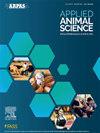Comparison of alternative backgrounding and feedlot system strategies on performance of May-born, Red Angus cross yearling steers in the Nebraska Sandhills
IF 1.5
Q3 AGRICULTURE, DAIRY & ANIMAL SCIENCE
引用次数: 0
Abstract
Objective
Our objective was to examine the physical performance and economic outcomes of differing backgrounding and feedlot systems on May-born yearling steers.
Materials and Methods
Steers weaned in January (n = 392) were blocked by BW and randomly assigned to 1 of 2 backgrounding treatments for 4 mo: given ad libitum meadow hay and 1.81 kg/d of a 33% CP supplement (HI) or allowed to graze dormant subirrigated meadow with 0.45 kg/d supplement (LO). In May, one-half of the steers from each backgrounding treatment were blocked by BW and transported to a feedlot system (S-YRL) before slaughter at 18.5 mo of age. The remaining steers grazed upland range (L-YRL), were transported to a feedlot mid-September, and were slaughtered at 21.5 mo of age. The net return of treatment for each study year was applied to 12 consecutive years of economic conditions.
Results and Discussion
There were no interactions between treatments. Backgrounding period ADG was 0.24 ± 0.03 kg/d greater among HI calves than among LO calves, which led to 31 ± 3.6 kg greater BW after backgrounding and 20 ± 7.7 kg greater BW at slaughter. However, LO calves had $209.46 ± $12.82 per head greater net return. Greater nutritional value in S-YRL steers at an earlier age led to 0.38 ± 0.03 kg/d greater ADG after the backgrounding period and 0.01 ± 0.003 greater G:F. However, L-YRL steers entered the feedlot 4 mo later with 99 ± 7.5 kg greater BW, a tendency for 0.08 ± 0.04 kg/d greater ADG in the feedlot, 39 ± 9.7 kg greater BW at slaughter, and $148.86 ± $38.72 per head greater net return. Marbling score, LM area, and YG were greater or tended to be greater for L-YRL steers, which led to greater empty body fat.
Implications and Applications
Backgrounding with greater inputs decreased net return, whereas extended grazing followed by a relatively shorter feedlot period decreased feed costs and increased net return.
内布拉斯加州沙丘地区5月出生的红安格斯杂交一岁阉牛的不同饲养背景和饲养系统策略的比较
我们的目的是研究不同背景和饲养场系统对五月出生的一岁阉牛的生理性能和经济结果。材料与方法1月断奶的阉牛(n = 392)以体重为指标,随机分为2种背景处理中的1种,分别饲喂草甸干草和1.81 kg/d 33%粗蛋白质(HI),或饲喂0.45 kg/d的休眠草甸。5月,在18.5月龄的屠宰前,每个背景处理中有一半的阉牛被BW阻塞并运送到饲养场系统(S-YRL)。其余的阉牛在高地牧场(L-YRL)放牧,9月中旬运到饲养场,在21.5月龄时屠宰。每个研究年的治疗净收益适用于连续12年的经济条件。结果与讨论治疗间无相互作用。背景饲喂期高体重犊牛的平均日增重比低体重犊牛高0.24±0.03 kg/d,导致背景饲喂后体重增加31±3.6 kg,屠宰时体重增加20±7.7 kg。然而,LO犊牛的净收益每头高出209.46±12.82美元。早期营养价值越高,背景期后平均日增重增加0.38±0.03 kg/d, G:F增加0.01±0.003 kg/d。然而,L-YRL阉牛进入饲养场4个月后,体重增加99±7.5公斤,在饲养场的平均日增重增加0.08±0.04公斤/天,屠宰时体重增加39±9.7公斤,每头净收益增加148.86±38.72美元。L-YRL的大理石纹评分、LM面积和YG更大或倾向于更大,这导致更多的空体脂肪。影响和应用背景:增加投入会降低净收益,而延长放牧时间后相对较短的饲养场周期会降低饲料成本并增加净收益。
本文章由计算机程序翻译,如有差异,请以英文原文为准。
求助全文
约1分钟内获得全文
求助全文

 求助内容:
求助内容: 应助结果提醒方式:
应助结果提醒方式:


